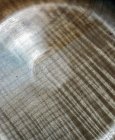Ok bowl gurus: I love to use shine juice over a shellac sealer on bowls. But I cannot seem to get the very center of the bowl to finish without a dull spot. I added a pic and I hope you can see the center spot I'm talking about. I've tried running it faster while finishing the center spot; but that doesn't seem to do anything. I know there's a trick and you guys know what it is! It's maddening! This bowl is local big leaf maple, after spinning on 4 or five coats (this is before final sanding and buffing), you can make out the dull spot in the center that I always seem to get.


